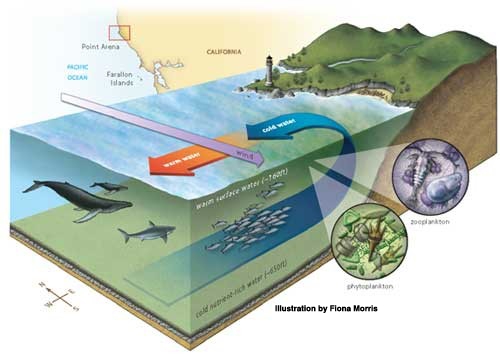Upwelling and the California Current
- The California current is the eastern boundary current of the North Pacific Gyre, running southward from British Columbia, Canada to Baja California, Mexico. This current draws cool, nutrient rich waters from the Alaska current down along the western coast of North America.
- Western boundary currents flow deeper and stronger than eastern boundary currents. This means that cool, nutrient-rich water is closer to the surface in eastern boundary currents than western boundary currents. This results in the creation of rich upwelling zones in areas with eastern boundary currents, such as the California Current.
- The intensity of the California current is influenced by strong northwesterly winds. These winds predominantly blow along shore, which because of the earth’s rotation (see Eckman transport) cause water to be transported in an offshore direction. This movement of water offshore causes cooler, nutrient rich water to be upwelled over the narrow continental shelf to the surface.

- Upwelled waters are high in nutrients, which cause high levels of production by phytoplankton. These phytoplankton are the base of the food chain, attracting high numbers of consumers.
- Upwelling in the California Current is influenced by seasonal changes in the intensity of northwesterly winds. The upwelling season is most pronounced in spring and summer, when northwesterly winds are at their highest of the year. Upwelling is reduced in fall and winter, when winds relax and are more variable.
- The intensity of upwelling varies along the California Coast in relation to the topography of the coastline. The shape and orientation of the coastline in relation to the direction of the winds can produce more or less favorable conditions for upwelling (www.oceanexplorer.noaa.gov).
- Bathymetry also can influence upwelling. Areas where the continental shelf is narrow and drops steeply to the deep ocean have more intense upwelling than areas with more gradual continental shelves that reach the deep ocean farther from shore. This is because less water needs to be displaced offshore by Eckman transport before cool water can rise from the deep ocean.
- Upwelling is also influenced by long-term climate patterns, including the Pacific Decadal Oscillation (PDO) and the El Nino Southern Oscillation (ENSO). PDO creates “warm” phases, during which time upwelling is weakened. Upwelling is intensified during “Cool” phases. The occurrence of El Nino is also associated with a warming of the Pacific, which weakens coastal upwelling in California.
Back to Top

